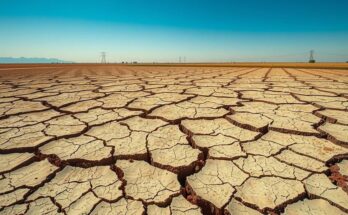Tropical Cyclone Dikeledi struck Madagascar on 11 January, impacting over 5,000 people and causing three deaths. Displacement of 352 individuals was noted, alongside damage to schools and infrastructure. The cyclone reached Nampula Province on 13 January, with severe weather expected to persist in the region. Humanitarian aid is being provided to those affected by the storm.
Tropical Cyclone Dikeledi impacted the northern region of Madagascar on 11 January, causing significant rainfall and high winds. The cyclone affected over 5,000 individuals, leading to three fatalities and displacing 352 people. The storm destroyed more than 60 schools, leaving approximately 750 children unable to attend classes. Humanitarian organizations are currently providing support to those affected by the cyclone.
As of 13 January, Dikeledi reached the tropical cyclone stage in Nampula Province, south of Ihla de Mozambique, bringing severely deteriorating weather across Nampula, Cabo Delgado, and Zambezia Provinces. Residents are enduring heavy and torrential rainfall, alongside destructive winds and dangerous sea conditions, particularly in areas close to the impact zone.
The National Office for Risk and Disaster Management (BNGRC) reported direct consequences of Cyclone Dikeledi, affecting 5,216 individuals, causing three deaths, and damaging nearly 1,300 houses. Additionally, 20 classrooms were destroyed, and five health centers were damaged, resulting in a significant number of children needing educational support. Many essential infrastructures are temporarily compromised, including a national road connecting the capital to the northern region.
Forecasts from the National Institute for Disaster Risk Reduction and Management (INGD) indicate that Cyclone Dikeledi will continue its path southward, potentially reactivating upon reaching the Mozambique Channel on 14 or 15 January. The cyclone could intensify and approach the western shores of Madagascar’s Toliara province. Heavy rainfall, severe winds, and thunderstorms are expected to persist in subsequent days, affecting even more regions after its initial passage.
Overall, with Dikeledi’s ongoing trajectory and forecasted reintensification, emergency response efforts are vital to mitigate further damage and assist affected populations across Madagascar and Mozambique.
In summary, Tropical Cyclone Dikeledi has significantly impacted northern Madagascar, leading to casualties, displacement, and extensive infrastructural damage. The affected regions face severe weather conditions and continuing risk as the cyclone approaches further, highlighting the urgent need for humanitarian assistance and effective disaster response. Continued monitoring and support efforts are critical as the situation develops in Madagascar and Mozambique.
Original Source: www.unocha.org




